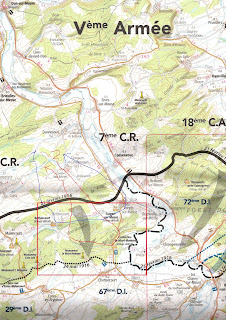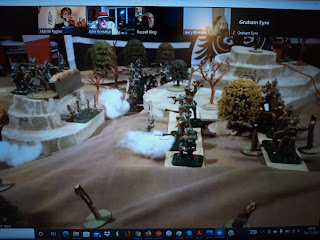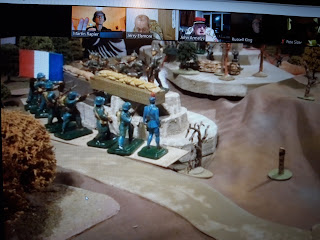In the break between Xmas and New Year, Tim put on a fairly ambitious 54mm WW1 game covering the attack by 22nd Reserve Division on the Mort Homme feature during the Battle of Verdun in 1916. He has just finished his 10 part blog post on it, so here is my more succinct recollection of the titanic struggle.
Russell and I were the staff of 22nd Div, while John and Jerry were the wicked French.
We had to do some pre-game planning and prep, first up was selecting some additional resources from a lengthy list of possibles. I plumped for some heavy artillery, stormtroops, control of the air, some air recce, a field hospital and improved telephone communications. Most importantly, a visit from a dignitary!
This was the general area of operations (Tim had scanned the maps). We had to mark up our rear area organisation and our assault plans.
We put our field guns on roads for ease of supply a couple of km in the rear. Divisional HQ was in the village just behind the artillery battalions. The heavy guns went further back, again positioned along some roads to ease the ammo supply.
The field hospital went in some woods just to the rear of Div HQ with a handy road adjacent.
The assault plan was quite straightforward. As per 1916 German doctrine I just divided up the assault zone into regimental sectors covering the whole depth of the enemy position, 43 Bde on the right, 44Bde on the left. The flanking regiments were to make subsidiary attacks, but the main effort was straight up the Mort Homme. IR 94was reinforced with the Corps Jager battalion and IR 32 with Stosstrupp von Gow.
The artillery fireplan was fairly simple. An initial stonk on the villages in the front line by the field guns, lifting to an intense barrage on the ridge. The heavies hit the road junctions behind the ridge. The second lift was timed for four hours, but could be initiated by the infantry with a flare signal and it lifted to valley on the far side of the ridge to interdict any counterattacks.
The subsidiary hill in front of IR 94 ('Artillery Hill') was heavily defended by the French, but as it came within the bombardment zone of the heavy guns as well as picking up overshoots from the barrage on the ridge, it was absolutely plastered by shells. The shelling destroyed much of the defences and inflicted some losses on the defenders.
Our air recce had shown up the positions around Coumieres ('Dog Hill') earlier, and again our shelling here was quite effective in thinning the defenders.
The view from Dog Hill was a bit alarming as IR 32 advanced in waves up the hill. I'm sure that big flag will come in handy.
Over towards the main Mort Homme ridge (Telegraph Hill), IR 92 swept forward through defensive French artillery fire. The shelling tore holes in the ranks of assaulting soldiers.
The Jagers and Stosstrupp were held in reserve to carry the second position. Here is 'Frothing von Gow' hmself, complete with wild staring eyes and huge moustache.
Meanwhile back at Corps HQ, there was much excitement as the visiting the dignitary arrived. The Kaiser himself! Mein Gott!! We are not worthy etc. I'd had to play vingt-et-un as part of the pre game prep to see who turned up. Those mis-spent years playing Blackjack had obviosuly paid off.
Our heavy gunners really go their eye in and knocked out on the the French batteries with a direct hit. You could hear the 'ping' as the matchstick hit it right across the Zoom link.
IR 94 was getting a bit close to our own barrage now, time for that second lift. Green flares soared into the sky.
Telegraph Hill was firmly in German hands and the field telephone team ran their wire up to establish an OP (the red thread is the phone line). IR 94 pressed on but French rifle and MG fire started to thin the ranks.
Meanwhile, back at Dog Hill, IR 32 suffered heavy losses from the French defensive fire and the leading ranks hit the ground to return fire. Against dug in defenders this was fairly hopeless and things started to look a bit shaky here. Stosstrupp von Gow double timed forward to restore the situation.
The arrival of reinforcements encourage the Landsers of IR 32 and the survivors bravely assaulted the French trench line. The French put up a stout fight and by now the Regiment was approaching half strength.
Meanwhile IR94 was well stuck in to Artillery Hill. A bloody melee ensued.
Stosstrupp von Gow reinforced the flanks of the assault on Dog Hill. Things started to look a bit shaky for the defenders, but IR 32 was down to 25% strength by now.
The Stormtroopers overran the French position and the flag bearer when down. Quelle domage!
The bloody battle for Artillery Hill continued to rage.
But the Germans eventually bludgeoned their way into the French trenches. German losses were actually lighter here although one of the battalions was badly knocked around.
We halted at that point and Tim asked us for our consolidation plan. Fortunately the Field Hospital we'd had the foresight to set up beforehand did a sterling job patching up the wounded and we could put three reasonably strong battalions in the front line (IR 32 had to be amalgamated into a single battalion).
The plan looked like this. We had an infantry battalion on each major hill, all wired together from the telephone exchange (the red lines). Our artillery SOS missions were the stars A(nton) and B(runo) plus the three forward positions themselves. The Stosstrupp and Jagers wer held in reserve to counterattack if needed.
A welcome reinforcement were some MG detachments and pioneers to help fortify the positions.
Telegraph Hill ended up as a virtual fortress. It reminded my of the 'Ant Hill' in Kubricks film 'The Paths of Glory'. The Jagers are lurking behind.
Even Dog Hill looked pretty solid with its MG nests.
Pretty soon after we'd finished digging in, the French airforce put in an appearance. Gott in Himmel! Fortunately their aim was quite poor and they scattered rather ineffective bombs across the battlefield. Unfortunately Tim had mislaid the box of French aircraft, so he showed us a picture of his excellent two seater conversion (featured on his blog).
A French priest then appeared and blessed the poor unfortunate French infantry regiment from 62nd Div tasked with retaking the lost ground.
A great mass of Horizon Bleu infantry appeared in front of Dog Hill, and ran straight into our SOS artillery barrage. Ouch. The phone lines in this sector were intact to call in the guns, so we didn't have to worry about the complex flare signal scheme I'd devised.
The French artillery bombardment was relatively ineffective, but did manage to cut the telephone wire to Dog Hill.
The French pressed on through a storm of MG and rifle fire with figures dropping left, right and centre.
The survivors made it to the German trenches, still led by their heroic Colonel in his pre war St. Cyr kepi.
And took Artillery hill after fierce hand-hand fighting. This incident was based on an account in Alistair Hornes 'The Price of Victory'. Against all the odds, one French regiment succeeded in breaking into the German positions.
This was, unfortunately, the cue for our pre-registered defensive barrage on the captured positions, while the defenders on Telegraph Hill kept them pinned with a torrent of rifle and MG fire.
As shells dropped all over the French, the observers on Telepgraph Hill called up the Jagers in reserve to counterattack.
By now the French numbers were quite thin, but defensive fire still inflicted a toll on the Jagers. This didn't stop them closing with the defenders.
The Germans made contact and swept over the defenders, killing or capturing all of them. Sadly, this was also the historical outcome, and the French Colonel was killed at the head of his Regiment.
What an outstanding game, very atmospheric and all the pre-battle prep really captured the feel of a WW1 battle. As Tim pointed out, in many cases, that was the interesting bit, as once the plans were made and the troops deployed, there was little the commanders could do to influence the outcome of the assault.
Many thanks to Tim for putting it on and all the other players for getting into the spirit of it. A very memorable experience. The missing aircraft also turned up eventually, hilariously their storage box had been incorporated into the pile of boxes underneath Telegraph Hill.


































Very nicely presented, thanks for all the work that went into that, a story well told.
ReplyDeleteThanks Norm. It was Tim who did all the hard work running it, but the frenetic planning phases before and during the game certainly added a lot to the period atmosphere.
DeleteFantastic write-up Martin, and thanks again for entering in to the spirit of the game with such enthusiasm.
ReplyDeleteThanks Tim. Thank you for putting it on.
DeleteHello Martin
ReplyDeleteA great read that really captured the fun you had playing it.